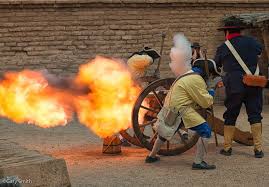Defender of St Louis
The Battle of Fort San Carlos
"...a little-known part of the history of the American Revolution..."
 "Mangez plomb, cochons!"
"Mangez plomb, cochons!"

"Eat Lead, You Pigs!"

While
Francois Valle first made his mark in the region as founder of French Colonial
Valles Mines after arriving from Quebec in 1748 and in later years, after moving to Ste Genevieve,
ultimately he served as Commandant of the Fort there.
He made history a second time 32 years [May 26, 1780] by risking everything
to help save a Spanish fort named Fort San Carlos from the British invasion. Sixty miles to the North, a vulnerable settlement
caught in a battle for the New World, is now a place today we call...
Saint Louis, Missouri.

"...In his early 70's and commandante of Ste. Genevieve, he sent his two sons and
all the Ste. Genevieve militia he could spare to the Spanish settlement at St. Louis in May
1780 to defend against the coming British-Indians' attack. " [With the attack on its way,
St. Louis had still not been fortified].
"In two weeks the garrison of 350 defenders withstood 1000 attackers. May 26th, outnumbered
3 to 1, the garrison still prevailed after a desperate struggle...It does not seem excessive to claim that the men
from Ste. Genevieve added the weight that tipped the scale of battle in favor of the defenders...
*...by royal decree on
April 1, 1782 King Carlos III of Spain conferred upon Francois I the rank of lieutenant in the regular
Spanish army. Francois Valle, French Canadian habitant, thus became a Spanish don..."
"...At the same time that the Franco-Spanish garrison repelled the Anglo-Indian attack on St Louis,
Colonel John Montgomery and General George Rogers Clark fended off a secondary British thrust at
Cahokia across the Mississippi. These British setbacks in the western theater of action are a
little-known part of the history of the American Revolution. Nonetheless, they prevented Great
Britain from seizing control of the lucrative fur trade of the lower Mississippi River,...."
From
Colonial Ste. Genevieve, Carl J. Ekberg 1996 pg. 66
|
See Also:
|
|
READ FIRST 70 PAGES - François Vallé and His World, Carl J. Ekberg 2002
|
|
READABLE ONLINE - Sainte Genevieve, Francis Yealy, S.J., Ph.D. (CANTAB.) 1935
|
|
PURCHASE REPRINT - Sainte Genevieve, Francis Yealy, S.J., Ph.D. (CANTAB.) 1935
|
From French Community to Missouri Town: Ste. Genevieve in the Nineteenth Century,
Bonnie Stepenoff, Ph.D. (University of Missouri Press, 2006)
|
*
NOTE 1: Valle gave the defenders a major tactical advantage in two ways, first by
supplying genuine lead musket and cannon balls and secondly, by supplying his
own Ste. Genevieve militia, well trained and equipped.
NOTE 2: Riflemen in those days knew the best projectiles came from casting their own. Making musket balls from lead
gave them huge knock-down power. Shooting pebbles did not carry far and had a lot less penetrating power. You can see
Mel Gibson in "The Patriot" for how he melted down his
murdered son's toy lead soldiers into musket balls.[0:38/1:35]
At 100 feet getting hit with a pebble or stone did not compare to the damage and knockdown power of a typical
52-caliber lead rifleball at that distance, even to this day used
for medium game [weighing] up
to 300 lbs. Lead is 15 times heavier than limestone [0.409 lbs/cu.in vs. dolomite's 0.0266 lbs/cu.in.).
"The Battle of Fort San Carlos [May 26, 1780]"
has been called the western-most battle of the Revolutionary War.
Commemoration Committee for the Battle of Fort San Carlos
For more info see
FrenchColonialLife.org
or call 573-883-3105, the Centre for French Colonial Life
or click here:
LITTLE KNOWN FACT: The ruins of Fort San Carlos are buried under Ballpark Village and The Spanish Pavilion nearby.
"...A Stunning Defeat" In October 1781, the war virtually came to an end when General Cornwallis was surrounded and forced to surrender the
British position at Yorktown, Virginia. Two years later, the Treaty of Paris made it official:
America was independent.
From USHistory.org
"Yorktown was the last major engagement of the war however there are documented cases of skirmishes
occurring up til late 1783. One of the last occured in New Jersey near Tuckerton on April 3, 1783."
From The State Of New Jersey's NJ Historic Trust, 11.The American Revolution
"August 27, 1782 - The last fighting of the Revolutionary War between Americans and British occurs with a skirmish in South Carolina along
the Combahee River. November 10, 1782 - The final battle of the Revolutionary War occurs as Americans
retaliate against Loyalist and Indian forces by attacking a Shawnee Indian village in the Ohio territory."
HistoryPlace.com
...France fought alongside the United States, against Britain, from 1778..."
Francois Valle supplied lead to the Revolutionary War effort as a Frenchman. The French were a great help to the
colonists, often at their own expense."
From Wikipedia's "France in the American Revolutionary War